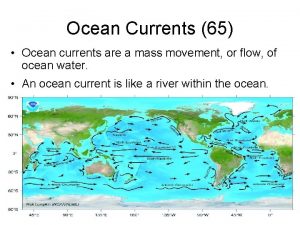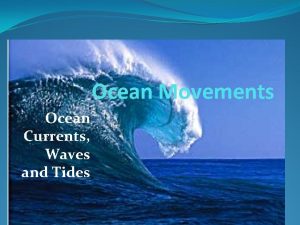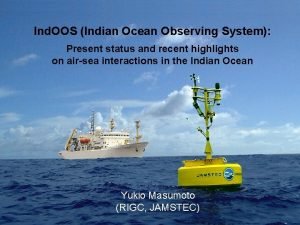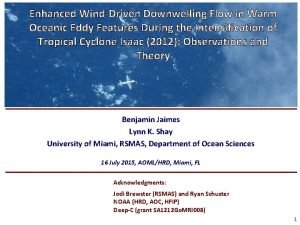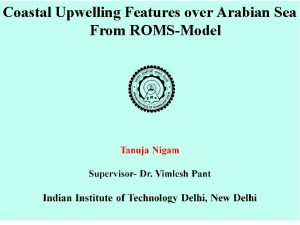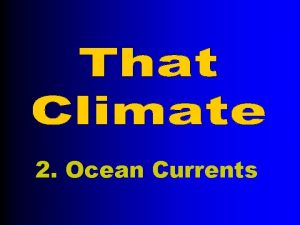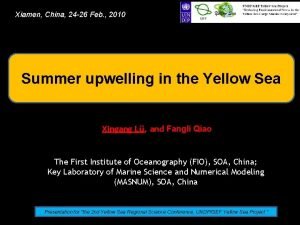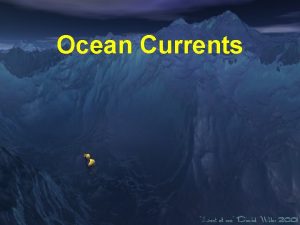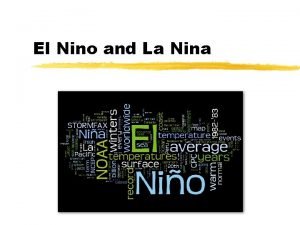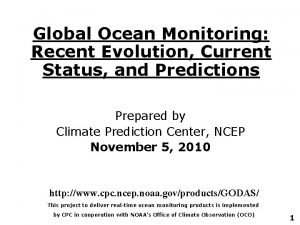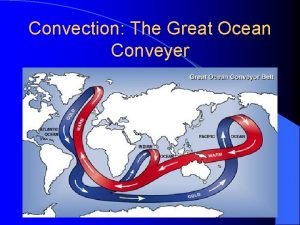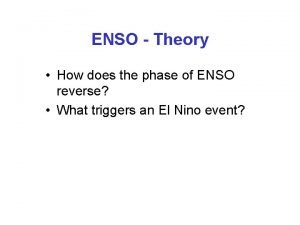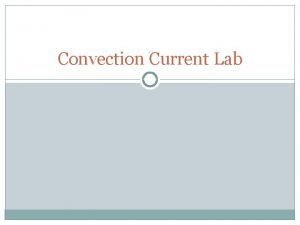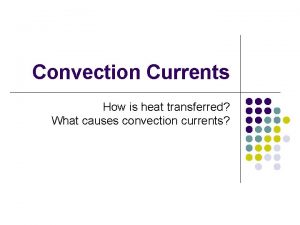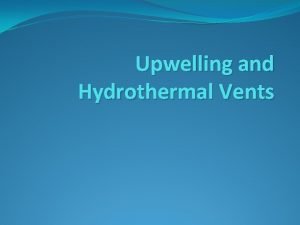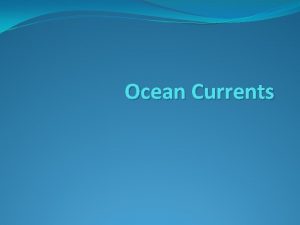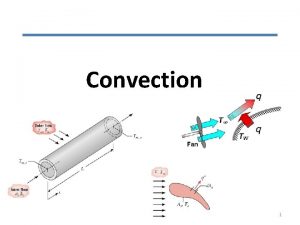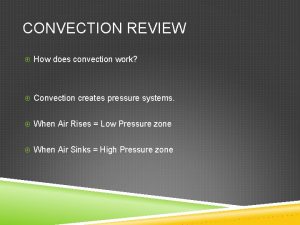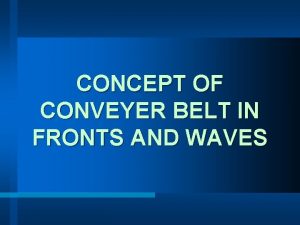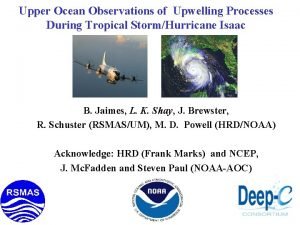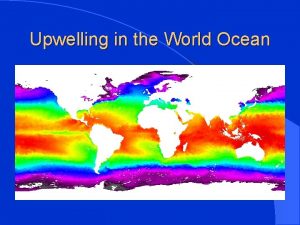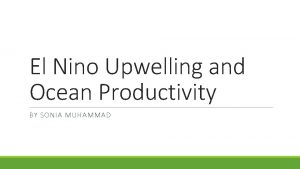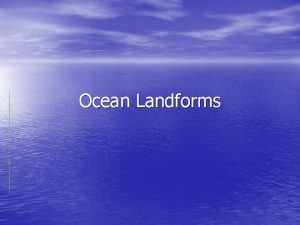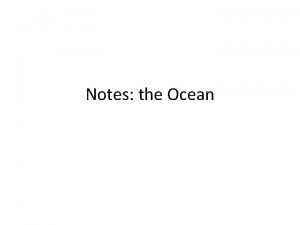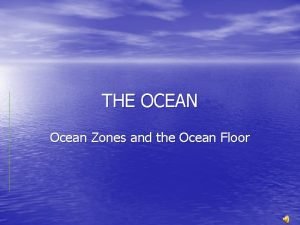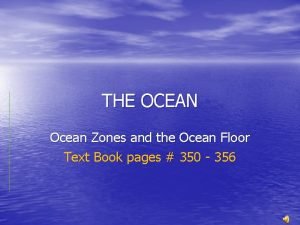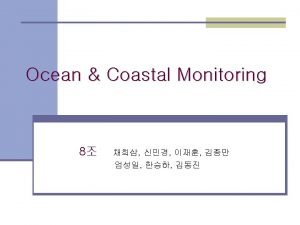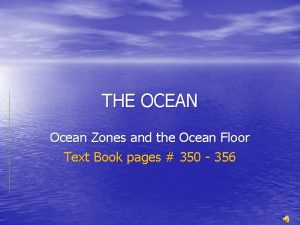Convection The Great Ocean Conveyer Also convection Upwelling





















- Slides: 21

Convection: The Great Ocean Conveyer

Also convection: Upwelling in the World Ocean

Mechanisms that create ocean upwelling l Wind l Coriolis Effect

Upwelling refers to deep water that is brought to the surface. Areas of upwelling are created by surface winds that pull water away from an area. This deficit of water on the surface invites water to come up from deeper regions.

Types of Upwelling l Equatorial l Coastal l Seasonal

1. Equatorial Upwelling Wat er Flow Upwelling

Look at the equator in the Pacific Ocean.

2. Coastal Upwelling (follow the black arrows)

What’s the difference between Peru(A) and Columbia (B)? B A

3. Seasonal upwelling Wind Onshore winds pile water up on shore, thus surface water will be forced downward. This is ‘downwelling’. Wind Offshore winds take water away from shore, thus water from depth will upwell to the surface.

The Monsoonal wind shifts in Oman create very different conditions. Wi nd April, 1999 Onshore winds: Downwelling Wi nd August, 1999 Offshore winds: Upwelling

Identifying upwelling on satellite-derived maps l Sea Surface Temperature l Ocean Color

The deep water that surfaces in upwelling is cold; by looking at Sea Surface Temperature maps we can identify cool upwelled water versus hotter surface water.

Upwelled water also contains nutrients (nitrate, phosphate, silicate) and dissolved gases (oxygen and carbon dioxide) that are not utilized at depth because of a lack of sunlight. Now on the surface, these nutrients and gases help to fuel photosynthesis by small algae called phytoplankton.

Phytoplankton photosynthesize using specialized color pigments called chlorophyll. Thus, “Ocean Color” maps are another way to identify areas of upwelling. Where on this ocean color map are high phytoplankton concentrations?

Ecological and Economic effects of upwelling: l Upwelling leads to more phytoplankton l More phytoplankton leads to more fish l More fish lead to commercial fishing jobs and to more seafood

Phytoplankton come in many shapes and forms. Collectively they form the base of oceanic food webs. Without upwelling many of the world’s fisheries would not thrive.

Some climatic events can reduce upwellings. ~ El Nino

Along Peru’s coast, an El Nino event decreases the coastal winds. Thus the upwelling from below is slowed. An El Nino condition results from weakened trade winds in the western Pacific Ocean near Indonesia, allowing piled-up warm water to flow toward South America.

Even though upwelling areas account for only 1% of the ocean surface, they support 50% of the worlds fisheries.

Upwelling and Fisheries January April July October Using this series of Sea Surface Temperature Maps from 1999, can you determine areas/times for possible fisheries? (Hint: Look at Peru’s coast in January and April. Look at the northwestern tip of Africa in July and October. )
 Upwelling in the ocean
Upwelling in the ocean Ocean upwelling
Ocean upwelling Ocean upwelling
Ocean upwelling Ocean upwelling
Ocean upwelling Coastal upwelling definition
Coastal upwelling definition Upwelling and downwelling
Upwelling and downwelling Upwelling
Upwelling Upwelling animation
Upwelling animation Causes of el niño
Causes of el niño Upwelling and downwelling
Upwelling and downwelling Upwelling
Upwelling Upwelling and downwelling
Upwelling and downwelling Convection currents ocean
Convection currents ocean Cause of convection
Cause of convection Ocean ocean convergent boundary
Ocean ocean convergent boundary Convergent vs divergent boundaries
Convergent vs divergent boundaries Scrat s continental crack up
Scrat s continental crack up Convergent plate boundaries
Convergent plate boundaries Ocean to ocean convergent boundary
Ocean to ocean convergent boundary Ocean ocean convergent boundary
Ocean ocean convergent boundary Red ocean blue ocean strategi
Red ocean blue ocean strategi Chapter 15 ocean water and ocean life wordwise answer key
Chapter 15 ocean water and ocean life wordwise answer key
